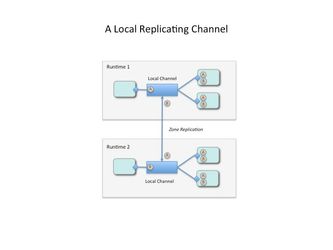This section outlines the differences between local and remote channels.
Local
...
Channels
Channels may be configured with bindings. If producers and consumers are connected to a channel with no bindings and all are in the same zone, the channel is local. That is, events will be sent in-VM and not over a remote transport.
...
In this scenario, events emitted by the producers on both runtimes will be received by all consumers connected to the channel in the zone. The following figure illustrates event replication:
Remote Channels
A channel is considered remote in two cases:
...
Remote Producers and Consumers
This allows events to be sent across clusters. Bindings are configured in the same way as references.
If no bindings are specified and a producer is defined in a composite that a channel is deployed to a different cluster ( zone ) than a channelthan connected producers or consumers, Fabric3 will automatically create a remote binding between the two. For example, if the BuyComponent in the previous example were deployed to a different cluster than the BuyChannel, Fabric3 will generate a remote binding to propagate messages from the producer component to the channel.bind the channel to a broadcast-capable remote transport (for example, a JMS Topic). In this scenario, events will be replicated to all connected consumers, regardless of their origin. The following figure demonstrates this:
